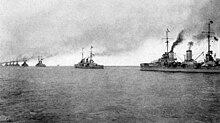At the start of the war, the German Empire had cruisers scattered across the globe, some of which were subsequently used to attack Allied merchant shipping. The British Royal Navy systematically hunted them down, though not without some embarrassment from its inability to protect Allied shipping. For example, the German detached light cruiser SMS Emden, part of the East-Asia squadron stationed at Tsingtao, seized or destroyed 15 merchantmen, as well as sinking a Russian cruiser and a French destroyer. However, the bulk of the German East-Asia squadron—consisting of the armoured cruisers Scharnhorst and Gneisenau, light cruisers Nürnberg and Leipzig and two transport ships—did not have orders to raid shipping and was instead underway to Germany when it encountered elements of the British fleet. The German flotilla, along with Dresden, sank two armoured cruisers at the Battle of Coronel, but was almost destroyed at the Battle of the Falkland Islands in December 1914, with only Dresden and a few auxiliaries escaping, but at the Battle of Más a Tierra these too were destroyed or interned.
Soon after the outbreak of hostilities, Britain initiated a naval blockade of Germany. The strategy proved effective, cutting off vital military and civilian supplies, although this blockade violated generally accepted international law codified by several international agreements of the past two centuries. Britain mined international waters to prevent any ships from entering entire sections of ocean, causing danger to even neutral ships. Since there was limited response to this tactic, Germany expected a similar response to its unrestricted submarine warfare.
The 1916 Battle of Jutland (German: Skagerrakschlacht, or "Battle of the Skagerrak") developed into the largest naval battle of the war, the only full-scale clash of battleships during the war, and one of the largest in history. It took place on 31 May – 1 June 1916, in the North Sea off Jutland. The Kaiserliche Marine's High Seas Fleet, commanded by Vice Admiral Reinhard Scheer, squared off against the Royal Navy's Grand Fleet, led by Admiral Sir John Jellicoe. The engagement was a stand off, as the Germans, outmanoeuvred by the larger British fleet, managed to escape and inflicted more damage to the British fleet than they received. Strategically, however, the British asserted their control of the sea, and the bulk of the German surface fleet remained confined to port for the duration of the war.
German U-boats attempted to cut the supply lines between North America and Britain. The nature of submarine warfare meant that attacks often came without warning, giving the crews of the merchant ships little hope of survival. The United States launched a protest, and Germany modified its rules of engagement. After the notorious sinking of the passenger ship RMS Lusitania in 1915, Germany promised not to target passenger liners, while Britain armed its merchant ships, placing them beyond the protection of the "cruiser rules" which demanded warning and placing crews in "a place of safety" (a standard which lifeboats did not meet). Finally, in early 1917 Germany adopted a policy of unrestricted submarine warfare, realising the Americans would eventually enter the war. Germany sought to strangle Allied sea lanes before the U.S. could transport a large army overseas, but were only able to maintain five long range U-boats on station, to limited effect.
The U-boat threat lessened in 1917, when merchant ships began travelling in convoys escorted by destroyers. This tactic made it difficult for U-boats to find targets, which significantly lessened losses; after the introduction of hydrophone and depth charges, accompanying destroyers might attack a submerged submarine with some hope of success. The convoy system slowed the flow of supplies, since ships had to wait as convoys were assembled. The solution to the delays was an extensive program to build new freighters. Troop ships were too fast for the submarines and did not travel the North Atlantic in convoys. The U-boats had sunk almost 5,000 Allied ships, at a cost of 178 submarines.
World War I also saw the first use of aircraft carriers in combat, with HMS Furious launching Sopwith Camels in a successful raid against the Zeppelin hangars at Tondernin July 1918, as well as blimps for antisubmarine patrol.



No comments:
Post a Comment